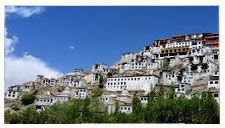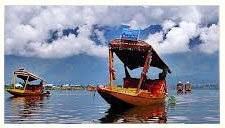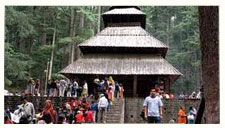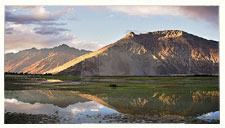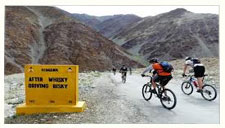Leh City
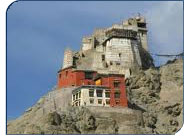 Leh, headquarter of Leh District is the largest town of the region. It is located to the north of the Indus River at an elevation of 3600m above the sea level. The town is dominated by the Namgyal Tsemo (victory peak) built by King Tashi Namgyal in 16th century, as a royal residence and the nine-storey Namgyal Palace built by King Sengge Namgyal on his victory in reunification of the Upper and Lower Ladakh in 17 century. Leh became the capital of Stod (upper Ladakh) during the reign of King Graspa Bum- Lde, who ruled Ladakh from 1400 to 1430 AD. In the later period, Leh became an important center for trade in Central Asia, along the Indus Valley between Tibet to the east, Kashmir to the west and ultimately between India and China.
Leh, headquarter of Leh District is the largest town of the region. It is located to the north of the Indus River at an elevation of 3600m above the sea level. The town is dominated by the Namgyal Tsemo (victory peak) built by King Tashi Namgyal in 16th century, as a royal residence and the nine-storey Namgyal Palace built by King Sengge Namgyal on his victory in reunification of the Upper and Lower Ladakh in 17 century. Leh became the capital of Stod (upper Ladakh) during the reign of King Graspa Bum- Lde, who ruled Ladakh from 1400 to 1430 AD. In the later period, Leh became an important center for trade in Central Asia, along the Indus Valley between Tibet to the east, Kashmir to the west and ultimately between India and China.
Right below Leh Palace is the old mosque, a Sunni Muslim mosque. It was constructed under the threat of military action by the Mughal Emperor Aurangzeb which prompted King Deldan Namgyal to build the mosque in 1661. The mosque reflects a mixture of Islamic and Tibetan architecture and can accommodate more than 500 people.
There is a religious coexistence of Buddhism and Islam, have been living in Harmony in Leh. Thus, Ladakh an ag-old tradition of cohesiveness Besides these two communities there are people living in the region who belongs to different religions like Christianity, Hinduism, and Sikhism. And they too live in harmony and forms a vital part of the society.The Christian community in Leh were converted from Tibetan Buddhism by German Moravian missionaries who first established a church in 1885.
In order to provide a transparent development in the area the conception of the council was conceived and Ladakh Autonomous Hill Development Council (LAHDC) was constituted in 1995. The council has 30 councilors, out of which 4 are nominated and rest are elected. The Chief Executive Councilor heads this council. He is also the Chairman of the council.
Unlike other districts of the State, LAHDC also governs the administration in Leh. The Deputy Commissioner, Leh also holds the power of Chief Executive Officer LAHDC.
In 1974 Ladakh was thronged open for foreign tourists. Since then Leh became the centre for tourism related activities in the region and today, Ladakh is among the most preferred tourist destination for foreign as well as domestic tourists.
Leh has a cold, arid climate with long, harsh winter season that is, from October to early March. The winter temperature in Leh dips down at maximum to -29 degree Celsius and during summers the mercury rises to a high of 33 degree Celsius.
Fact File
Leh provides medium and lower class accommodation, with hundreds of guesthouses and hotels, which can suit every budget. There are number of good restaurants that offers palette of good multicuisine dishes for a reasonable price. There are number of tour Operator/Travel Agents around the town, which look after traveler's requirements like booking oh hotels, providing tour guides, different tour packages and taxi services etc.
 Buddhist monasteries are the must visit places in and around Leh. Tour to these monasteries can be organized in one or two days, as all the famous monasteries are within a drive of one or two days from Leh. For information on monasteries please check monastery section of this web site.
Buddhist monasteries are the must visit places in and around Leh. Tour to these monasteries can be organized in one or two days, as all the famous monasteries are within a drive of one or two days from Leh. For information on monasteries please check monastery section of this web site.
A building in the grand tradition of Tibetan architecture said to have inspired from the famous Potala in Lhasa, which was built half a century later. The palace was built in the 17th century and had nine storeys , but it is now dilapidated and deserted. It was the home of the royal family until they were exiled to Stok in the 1830s. Within the palace are Buddhist wall paintings, centuries old 'tankas' or painted scrolls and other artefacts. Above the palace, at the top of the Namgyal hill, is the Victory Tower, built to commemorate Ladakh's victory over the Balti Kashmir armies in the early 16th century. This palace built for King Singge Namgyal, now houses the Ladakhi branch of the Indian Government's archaeological conservation organisation.
The view from the monastery above the Leh Palace is quite impressive. It is known as Namgyal Tsemo Gompa (monastery). The red monastery has some frescos, Buddhist scriptures, idols and a massive statue of the Maitreya Buddha (future Buddha).
The palace is always open for public visit and the restoration work is on. You can get to the roof of the Leh Palace, Ladakh to enjoy a panoramic view of the whole Leh town. From upon the roof of the palace, you can also view the mountain of Stok Kangri and some part of the Zanskar mountain across the Indus Valley (to south) and the Ladakh mountain ranges (to north).
Shanti Stupa:
Japanese Stupas made for world peace. Shanti Stupa is located at Changspa, on the hilltop, and was inaugurated by Dalai Lama in 1985. Its state of the art work attracts a lot of tourists to Ladakh and is spectacular to watch. The Shanti Stupa can be reached by car, or on foot via a steep flight of five hundred steps.
You will enjoy the panoramic view of the chain of mountains and the peaceful little village of Changspa with typical Ladakhi houses built along a gushing stream, and the towering Namgyal Tsemo in the distance.
Hall of Fame
Hall of Fame near Leh is worth a visit for every citizen. It is a glorious museum constructed by Indian army. You can see the memorabilia, eminent defence personalities with biographies, images and weapons used during Kargil war and belongings of enemy soldiers found at war site. Another section of this building is entirely dedicated to Siachen and its heroes. On display are attires, multi layered shoes to keep their feet from frost bites, their daily instruments, their day to day food mainly frozen and packed, which is heated by lighting small balls of Hexamycin tablets, as fire is difficult to ignite at a temperature dipping -30 deg to -50 deg centigrade. It is mentioned on a board that 97% of the casualties in Siachen are due to cold and terrain.
MAGNETIC HILL
Defying the Law of gravity. This place is close to the Gurdwara Shri Patthar Sahib. It has been noticed that when a vehicle is parked on neutral gear on this metallic road the vehicle slides up.
GURDWARA SHRI PATTHAR SAHIB
The Shrine known as Gurdwara Patthar sahib is situated about 25 kms. Short of Leh town on the Leh-Srinagar road. Built in the everlasting memory of Shri Guru Nanak Dev, the great prophet who sanctified the place by his sacred visit during the year 1517 while on his second missionary tour. The Guru reached here via Nepal, Sikkim, Tibet, Yarkand and Leh after having spiritual discourses with the Sidhas at Mount Sumer (Central Himalayas).







 Thanks a lot for special and memorable holidays in leh Ladakh thank you so so much-really appreciate your fantastic service which you did for us!
Thanks a lot for special and memorable holidays in leh Ladakh thank you so so much-really appreciate your fantastic service which you did for us!


